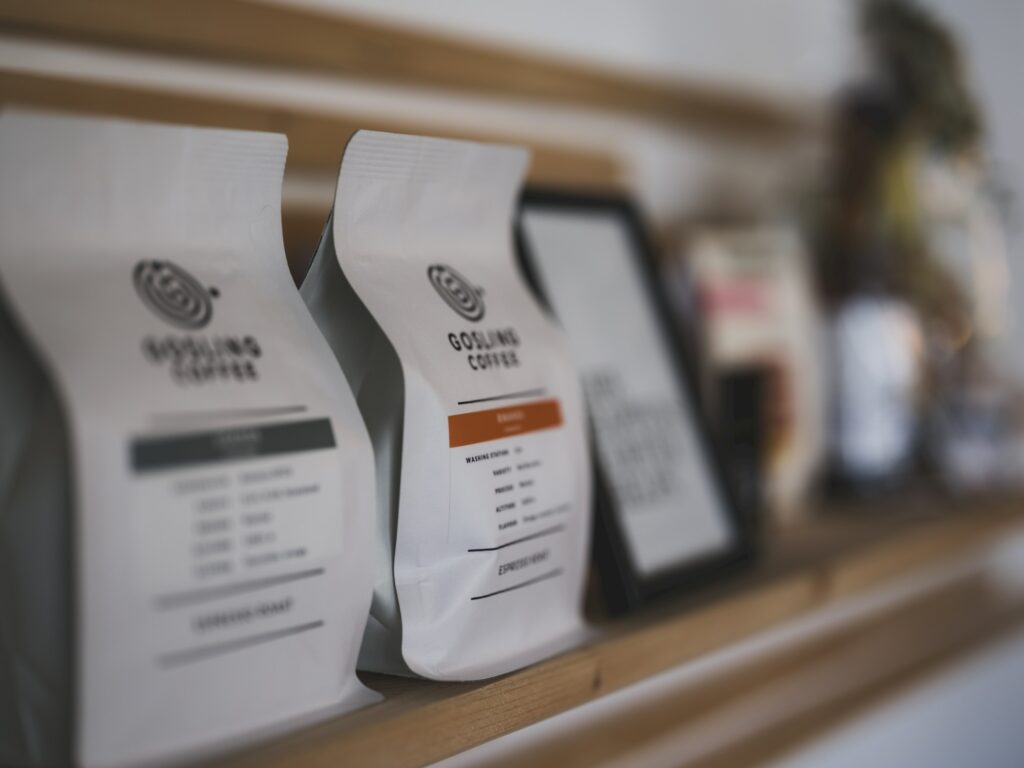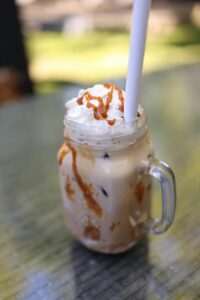Some people swear by hazelnut or vanilla-infused beans, while others roll their eyes and call it coffee blasphemy.
Walk into any grocery store and you’ll see bags promising caramel swirls, pumpkin spice magic, or even blueberry pie in a cup.
But are flavored coffee beans actually worth the hype, or are they just clever marketing dressed up as dessert? Let’s dig in and find out!
What Are Flavored Coffee Beans?
Flavored coffee beans start as regular roasted beans, but after roasting, they’re coated with oils or extracts that carry specific flavors, which is why you’ll see options like hazelnut, vanilla, caramel, pumpkin spice, or even chocolate and festive holiday blends lining store shelves.
This process is different from adding flavored syrups or creamers to your cup because those mix into the liquid coffee itself, while flavored beans carry the taste from the very first grind, infusing the aroma and flavor right into the brew.
The result can be convenient and fun, giving you the sense of a café-style drink without reaching for extra bottles or dairy.
At the same time, it’s worth noting that the flavor is often more pronounced and consistent in the beans than it would be if you tried to replicate it with spices alone, which is why flavored beans feel like a shortcut for coffee drinkers who want something sweet, bold, or seasonal without the fuss.
The Appeal of Flavored Coffee
Convenience: Flavor Built Right Into the Beans
One of the biggest draws of flavored coffee beans is how effortless they are.
You don’t need to stock a lineup of syrups, creamers, or spices to change up your morning brew because the flavor is already baked in, so to speak. Just grind, brew, and sip.
For busy mornings or people who want a quick splash of flavor without extra steps, this can feel like a lifesaver. It’s coffee and dessert all in one scoop, no measuring required.
Variety: Endless Choices for Adventurous Drinkers
If you get bored easily, flavored beans are like a playground for your taste buds. Today it’s French vanilla, tomorrow maybe toasted coconut, and by next week you’re sipping pecan pie in a mug.
Brands know this too, which is why the shelf seems to expand with every wild idea—maple bacon, anyone?
For coffee drinkers who see their morning cup as a mini adventure, the endless options keep things exciting.
Dessert Replacement: Sweet Flavor Without Sugar
Another reason flavored beans shine is their ability to scratch that dessert itch without the guilt. Many people are cutting back on sugar, but still crave something that feels indulgent.
A cup of caramel-flavored coffee can deliver that sweet, cozy vibe without dumping spoonfuls of sugar into your cup.
It tricks the brain a little because your taste buds register “treat,” while your waistline breathes a sigh of relief.
Seasonal Hype: Pumpkin Spice and Holiday Blends
And then there’s the seasonal craze. Pumpkin spice in the fall, peppermint mocha in December—these flavors aren’t just drinks, they’re cultural events.
Coffee brands cash in on the excitement, and people happily join the ride because sipping that holiday flavor feels like participating in the season itself.
It’s part coffee, part tradition, and part Instagram-worthy moment.
The Downsides and Criticisms
Artificial Taste: Masking the Real Coffee
One of the biggest gripes about flavored beans is that they often taste more like candy than coffee.
The artificial oils can overpower the natural character of the beans, leaving you with something that feels more like a flavored drink mix than a carefully roasted cup.
If you’re someone who loves the subtle fruit or chocolate notes that come naturally from good beans, flavored versions can feel like they’re drowning out the very thing you came for.
It’s a bit like putting ketchup on a steak—sure, it adds flavor, but you lose the nuance.
Quality Concerns: Lower-Grade Beans as the Base
Another issue is quality. Some companies use lower-grade beans as the foundation for their flavored varieties, assuming customers won’t notice under the added vanilla or hazelnut.
That means you might be sipping on coffee that’s a notch below what you’d usually buy, but dressed up in a sweet disguise.
Residue: A Mess in Your Grinder
Then there’s the practical side, as flavored oils can leave a sticky residue behind.
Over time, that buildup clogs grinders and coffee machines, changing the taste of future brews and sometimes even causing mechanical issues.
Think of it like cooking bacon in a nonstick pan every morning but never washing it properly. Eventually, everything you make ends up tasting like bacon, whether you wanted it or not.
Purist Perspective: Coffee Without the Perfume
Finally, there’s the purist stance. For many coffee lovers, the joy of the drink comes from exploring beans based on origin, roast, and processing method.
To them, flavored coffee feels like spraying perfume on top of a bouquet—it hides the natural beauty rather than enhancing it.
These folks argue that coffee already has incredible, naturally occurring flavors, and adding artificial ones just muddies the experience.
Health and Ingredient Considerations
Ingredients Used: Natural Extracts vs. Artificial Flavorings
Not all flavored coffee beans are created equal. Some brands use natural extracts like real vanilla or cocoa to give their beans a subtle, authentic taste.
Others rely on artificial flavorings and chemical compounds to mimic those same notes.
The difference matters because natural extracts usually create a smoother, less harsh flavor, while artificial ones can taste sharp or overly sweet.
It’s a bit like the difference between fresh-squeezed orange juice and a powdered mix; both taste like orange, but one clearly feels closer to the real thing. Reading the label is your best friend here.
Calorie Impact: Almost Nothing Compared to Syrups
One of the perks of flavored beans is their calorie count, or lack of it. Most flavored beans add virtually no calories to your cup because the oils used for flavoring are applied in tiny amounts.
Compare that to syrups or creamers, which can quickly turn a plain black coffee into a dessert-level drink with sugar and fat.
If you’re watching your intake but still want a treat-like experience, flavored beans offer a way to get that cozy feeling without blowing your daily calorie budget.
Sensitivities: Possible Allergens in the Mix
Flavored beans aren’t completely risk-free, though. Some use nut extracts or other ingredients that can trigger allergies or sensitivities.
For example, a “hazelnut” flavor may contain actual nut-based oils, or it may just be a synthetic copy. Either way, if you have allergies or dietary restrictions, it’s smart to check the ingredient list carefully.
It’s the same as reading the fine print on a snack bar because what seems harmless at first glance might not be friendly to everyone.
Flavored Beans vs. Natural Flavor Notes
Coffee already has its own built-in personality, with beans from different regions carrying natural hints of chocolate, fruit, nuts, or even spices depending on where and how they’re grown.
For instance, an Ethiopian coffee might naturally give you a whisper of blueberry, while a bag labeled “blueberry-flavored” coffee often hits you over the head with something that tastes more like candy than fruit.
That’s the real debate—do flavored beans add to the experience or take away from what coffee already offers on its own?
Some people love the extra punch, saying it makes their morning cup feel fun and unique, while others argue it overshadows the delicate flavors that make each origin special.
In the end, it comes down to what you’re looking for: a natural tasting journey where the beans speak for themselves, or a bold, flavored shortcut that guarantees consistency with every sip.
Who Should Try Flavored Coffee Beans?
Beginners: A Gentle Gateway
For people just stepping into the world of coffee, flavored beans can act like training wheels.
The added vanilla, hazelnut, or caramel softens the sharp edge of bitterness that often turns beginners away. It’s a smoother entry point that makes coffee feel less intimidating and more approachable.
Think of it as dipping your toes in the shallow end before swimming laps in the deep.
Occasional Drinkers: A Fun Treat
Not everyone drinks coffee daily, and that’s where flavored beans shine.
If you’re more of a “weekend brunch” kind of drinker, grabbing a bag of seasonal or dessert-style beans can feel like a fun treat without cluttering your pantry with syrups and extras.
It’s a quick way to add variety without turning your kitchen into a mini café.
People Reducing Sugar Intake: Sweet Without the Guilt
For anyone trying to cut back on sugar but still craving something indulgent, flavored beans can be a clever workaround.
They deliver that sense of sweetness through aroma and taste without actually piling sugar into your cup.
It tricks your senses into thinking you’re having dessert, but without the spoonfuls of sweetener. That makes them a solid choice for the calorie-conscious crowd.
Not Ideal For: Purists and Espresso Fans
On the flip side, flavored beans aren’t for everyone.
Coffee purists who savor the unique notes of single-origin beans often see flavored varieties as masking what makes coffee special in the first place.
Espresso lovers may also find them too overpowering, since the concentrated brew exaggerates the artificial taste.
If you live for tasting the difference between a Colombian and an Ethiopian roast, flavored beans might feel more like noise than music.
Alternatives to Buying Flavored Beans
Use Syrups or Creamers for Flexibility
If you like variety, syrups and creamers are the easiest way to switch things up without committing to a whole bag of flavored beans.
A pump of vanilla one day, caramel the next, and you’re in control of the flavor, strength, and sweetness.
Plus, you can mix and match to create your own combos, something pre-flavored beans can’t offer.
It’s like having a flavor wardrobe where you pick your outfit each morning instead of wearing the same shirt all week.
Experiment with Spices During Brewing
Another fun (and often cheaper) alternative is using spices while you brew.
A sprinkle of cinnamon in your grounds, a dash of nutmeg, or even a hint of cardamom can transform your cup without artificial oils.
These ingredients add warmth and complexity, and you can adjust the amount until it’s just right.
Infuse Beans at Home with Vanilla Pods or Cocoa Nibs
For the DIY crowd, infusing beans at home is a simple project with big payoff.
Toss a few vanilla pods, cocoa nibs, or even dried orange peel into an airtight jar with your beans, let them sit for a few days, and voilà—custom flavored coffee that tastes fresher and more natural.
The best part? You know exactly what went into it. No mystery oils, no strange aftertaste, just your favorite beans with a subtle twist.
Final Words
Flavored coffee beans can be a quick ticket to variety and fun, but they’re not always the highest-quality option.
For some, they’re a playful way to shake up a morning routine; for others, they feel like covering up the true voice of the bean.
The only way to know where you stand is to taste for yourself.
Grab a small bag of flavored beans, brew it alongside your favorite origin coffee, and see which cup wins your heart or at least makes you smile!
FAQs
Do flavored coffee beans have sugar in them?
Most flavored coffee beans don’t contain actual sugar. The flavor usually comes from oils or extracts added after roasting. That said, always check the label as some brands sneak in sweeteners.
Are flavored beans safe for coffee machines?
They won’t break your machine, but the oils can leave a sticky residue. Over time, this buildup can clog grinders or affect taste. Regular cleaning is a must if you brew flavored beans often.
Can you get high-quality flavored coffee beans?
Yes, but they’re harder to find. Many companies use lower-grade beans since the flavoring masks imperfections.
Specialty roasters sometimes offer premium flavored options, but they’re the exception, not the rule.
How long do flavored beans stay fresh?
Flavored beans usually lose their punch faster than plain ones.
The oils can fade or turn stale within a few weeks. For the best taste, buy small amounts and use them quickly.
Is there a difference between flavored ground coffee and flavored whole beans?
Yes. Whole beans tend to hold flavor longer and give you more control over freshness when you grind before brewing.
Pre-ground flavored coffee is convenient, but it loses both aroma and flavor faster.



